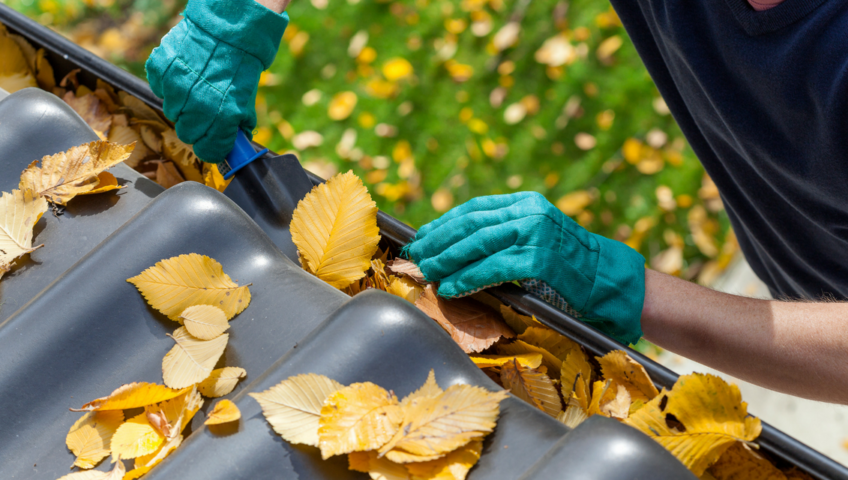Don’t wait until your rain gutters leak and sag from clogged debris. Preventive measures can save you a significant amount of money and avoid the headache of dealing with damage. Clogged gutters are a major reason for roof leaks and are entirely avoidable—discover 7 effective methods to prevent leaves and other debris from clogging your gutters.
Maintain Your Gutters
Properly functioning gutters and downspouts require regular maintenance to keep them clear of leaves and debris. You can either attempt this task by climbing a ladder or save time and effort by enlisting the help of a professional gutter cleaning company. You should clean your gutters at least twice yearly, although the frequency may increase if your property is surrounded by trees or frequently impacted by storms.
Tips for Efficiently Cleaning Your Gutters:
Leaf Blower or Hose
When clearing debris, opt for a leaf blower, but ensure your safety by donning protective goggles, a dust mask, and sturdy work gloves.
Gutter Trowel
To properly clean your gutters, use a garden trowel or gutter scoop to remove debris by hand. Begin at the low end of the gutter near the drain outlet for optimal results. Collect the debris in a bucket for easy disposal once you finish. It is recommended to clean gutters when leaves are slightly damp, not soggy. Additionally, use a leaf blower to clear any debris or leaves from the roof to prevent them from ending up in the gutters during the next rainfall.
Gutter Hose or Wand
Get your gutters clean swiftly and easily with these spray methods. First, attach a cleaning wand to a hose and spray the leaves out from one end to the other. This method can be done safely from the ground with eye protection being a must. If that doesn’t work, climb a ladder to see where the blockages are and flush the gutters with the hose. Try these spray methods to keep your gutters flowing clean.
Gutter Guards
One of the best ways to keep leaves out of gutters is with gutter guards. Gutter guards are designed to prevent leaves, twigs, and general debris from getting inside your gutters while still allowing water to flow freely. There are eight types of gutter guards you should be familiar with to keep your gutters clean.
Nylon
Nylon gutter guards are the best option for cooler climates as they work to help stop ice and snow accumulation. The other benefit of nylon gutter guards is that they can fit directly into the gutter without being attached to your shingles.
Micromesh
This gutter guard consists of a frame and mesh filter available in various sizes to fit any type of gutter. Micromesh allows large amounts of water to flow through the gutters while still keeping leaves out. Micro mesh guards are made of durable vinyl, plastic, or metal. This innovative design allows water to flow smoothly through. The downfall of micro mesh is they can be difficult to install, so it’s important that you hire a professional to install micromesh guards.
Bottle Brush
Bottlebrush gutter guards have bristles that point outwards to prevent debris from entering the gutter, while still allowing water to flow through the gutter freely.
Reverse Curve
This type of gutter guard is typically made from vinyl or metal and specializes in preventing large debris from entering the gutter. The downside of reverse curve gutter guards is they don’t handle large amounts of water well and can cause the rainwater to overshoot the gutter and fall to the ground.
Slit Gutter Covers
Slit gutter covers are similar to the reverse curve guard and work to increase the flow of rainwater into the gutter. Like the reverse curve, slit gutter covers struggle with large amounts of rainwater.
Sponge or Foam Guards
Sponge or foam-like guards are placed in the gutter and allow water to flow through while blocking debris and working to keep leaves out of your gutters. The problem with sponge guards is when seeds get caught in the sponge, the seeds can sprout into plants, causing even more issues.
With so many gutter guard types, choosing the best one for your home can be hard. Your best bet is to call in the professionals! To determine the best type of gutter guard for your home, call our experts at New Vision Exterior Solutions for a consultation today!
Trim Nearby Trees
Maintaining the trees near your house is crucial to prevent damage to your property. While lower branches can be managed with a pole saw, higher branches require the expertise of a professional with the right tools and training for safe pruning. They can trim the tree evenly to make sure it maintains its balance. Otherwise, a limb-heavy tree could fall in that direction, causing damage to your property. For extremely tall trees, topping off part of the tree can prevent breakage in adverse weather, all without killing the tree. Professionals can cut the trees around your home completely if they interfere with your property. Prioritize tree maintenance to protect your home and ensure your safety.
Gutter Screens
With various gutter screens and brands available, cleaning gutters has become less of a hassle.
Metal Screens
Metal screens lay on top of the gutter and then lock onto the outside. Metal screens are easy to install and inexpensive.
Plastic Gutter Screens
While they excel at keeping leaves out, be aware that seeds and pine needles can still pass through. However, these adaptable screens can be used with various roofing materials to provide reliable protection for your home.
Surface Tension Guards
Surface tension guards are solid pieces of metal that allow water to track the surface of the guard. These guards guide the water into the gutter and prevent the water from spilling over the gutters. Like all gutter guards, surface tension guards work to keep leaves out of gutters and keep your gutters clean. Certain surface tension guards have clips to easily inspect your gutters for debris.
Install Leaf Catchers
Unlike screens and guards that trap debris on the roof, the leaf catcher collects debris as it flows down the downpipe closer to the ground. It’s compatible with 2 ¾ flush mount or K-Funnel outlets and can be easily installed on your existing downpipes with minimal maintenance. With the leaf catcher, you can remove debris with your hand and avoid using a ladder altogether.
Install an All-in-One Gutter System
An All-in-One Gutter System is an effective choice, consisting of a gutter and a cap that blocks leaves and debris. Though it’s pricier, it’s a permanent solution that saves you time and effort in the long run.
Clogged rain gutters can cause major damage if left unattended, and homeowners should take proactive steps to protect their homes from such wreak havoc. With these 7 methods for preventing debris clogs, the hassle of cleaning out your rain gutters is now a thing of the past! Gutters are important to protecting your roof and should be checked regularly for proper maintenance. If you spot any early signs of damage, contact a local professional to assess the extent of the problem and offer ideas on how to fix it. Just remember, don’t wait until it’s too late—prevention is key to protecting your home from costly repairs!

